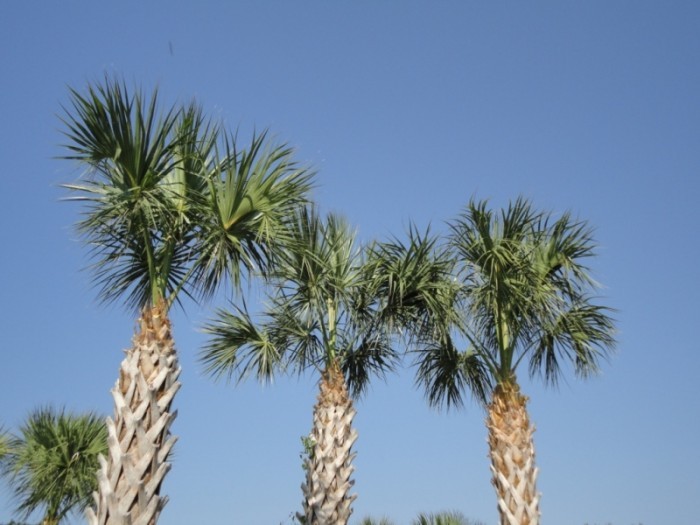
Hurricane season is upon us and many people are turning their thoughts to hurricane preparedness. One chore which you can safely eliminate from your “to-do” list is the dreaded “hurricane cutting” of Sabal palms.
This practice involves removing the lower fronds, even healthy green ones so that the resulting outline of the tree canopy occupies the 11 o’clock to 1 o’clock position of a clock face. People mistakenly believe that reducing the number of leaves will better prepare palms against strong winds. Over-pruning of palms is a puzzling trend with no sound basis in horticulture.
Observations from the 2004 hurricane season showed that palms that were hurricane pruned were more likely to snap than palms not pruned in this way. Another reason lower fronds are removed by tree trimmers is to gain easy access to the seed stalks, which can be removed without harming the tree.
Green fronds are the palms natural food manufacturing facility. Cutting healthy green fronds removes valuable nutrients and permanently stunts growth. Excessively pruned palms are more prone to disease and are more likely to succumb to high winds and winter freezes.
Sabal palms have evolved to deal with hurricanes and will rarely shed green leaves in high winds. Even brown fronds are generally too soft to become damaging missiles.
If the central frond of a palm tree is damaged, the palm will die. The surrounding fronds protect the heart of the tree from winds and frost and should never be removed. Most palms in South Florida are naturally potassium deficient and annually grow only half the number of leaves that they would otherwise.
Even removing yellowing leaves can exacerbate this problem and lead to a gradual decline of the palm’s health. The only time a “hurricane cut” should be done is when a Sabal palm is being transplanted to a site with no irrigation.
All of the fronds are removed prior to transplanting. This type of cutting directs the energy of the tree to re-establish the root system.
Research has shown that the Sabal will establish faster if all of the fronds are removed at the time of transport. This practice should not be done, however, on any established palm. The scientific name of the Sabal or Cabbage palm is Sabal palmetto.
It is the state tree of Florida and symbolizes the natural beauty of the Sunshine State. The State Seal of Florida depicts a beautiful full-figured Sabal Palm.
You won’t find any hurricane cut palms in a Highwaymen painting.
For a healthy, “picture-postcard” hurricane resistant Sabal palm, follow these simple points: Remove only leaves with leaf tips hanging below the horizontal line. The outline of the resulting canopy should occupy at least the 9 o’clock to 3 o’clock position.
Proactively removing lower brown fronds will help reduce cleanup operations if ever a high wind event does occur.
Ask your tree care company to follow the American National Standard for pruning trees, called ANSI A300 Part 1 Pruning or simply the “A300 pruning standard.”
Prune according to need, not to a schedule. Annual pruning is unnecessary. You can prune any time of year but it is better to prune from end of August onwards. If you prune too early in the year you will miss a lot of the young flower stalks and may have to prune twice! Never allow a tree trimmer to climb any tree with spikes.
Never pull the leaves off by hand. Leave short cleanly cut stubs or “boots.” Do not “de-boot” the leaf bases on the trunk. The lattice of boots is part of the tree’s architecture and adds to stability in high winds. Older, loose boots can be pulled off by hand if necessary. Use a proper slow release palm fertilizer three times a year, not a lawn fertiliser. It can take more than three years to correct a potassium deficiency but a correctly fertilized palm will have less brown leaves and will require less pruning.
Diligence and patience pays dividends. Palms are low maintenance trees and do not need to be overly manicured. Following these steps will not only save unnecessary expense, but will help showcase the natural beauty of Florida’s State tree.



